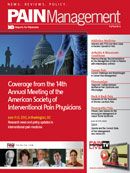Publication
Article
Pain News & Notes: June 2012
A look at pain management news and notes, June 2012.
As part of our continued effort to provide pain professionals with the resources they need, PainLive presents summaries of ongoing research and news in a broad range of pain management topics.
Zogenix Submits NDA for Zohydro
In early May, Zogenix submitted a New Drug Application to the FDA for Zohydro (hydrocodone bitartrate extended-release capsules), the company’s “lead investigational product candidate for the treatment of chronic pain.” The NDA was based on study data involving more than 1,100 patients that show treatment with Zohydro “resulted in significantly improved chronic pain relief compared to placebo” and was generally safe and well tolerated.
Senate Version of FDA User Fee Reauthorization Bill Would Reclassify All Hydrocodonecontaining Drugs as Schedule II
A provision to the FDA bill passed by both houses of Congress would “reclassify hydrocodone-containing combination products as Schedule II controlled substances.” The American Pharmacists Association and other groups oppose such a move, claiming in a letter sent to the Senate sponsors of the provision that “moving all of these hydrocodone products to Schedule II will result in significant barriers for patients who have a legitimate need for these products, and it will result in adding to the nation’s healthcare costs with no assurance of a reduction in diversion and abuse.”
Senate Launches Investigation into Ties between Pain Drug Makers, Non-profits, and Professional Societies
The US Senate Finance Committee has asked the American Pain Society, the American Academy of Pain Medicine, and other organizations “to disclose any financial ties or collaborations with pharmaceutical companies that manufacture opioid medications.” Letters asking for similar disclosures of financial relationships were also sent to Purdue Pharma, Johnson & Johnson, and Endo Pharmaceuticals.
Study Shows Nucynta Effective in Relieving Pain Associated with Diabetic Peripheral Neuropathy
Data from a phase III study showing that Nucynta ER extended-release tablets “were significantly more effective than placebo in providing pain management among adults with chronic moderate to severe, painful diabetic peripheral neuropathy” were presented at the 2012 annual meeting of the American Pain Society. In the study, patients who had “at least a one-point reduction in pain intensity during three weeks of treatment with tapentadol ER” who continued on “an optimized dose of tapentadol ER (100-250 mg twice daily) for an additional 12 weeks” experienced “significantly better pain control” compared to patients who switched to placebo.
Reformulated OxyContin Reduces Abuse Potential
Data from the NAVIPPRO sentinel surveillance network system presented during the American Pain Society 31st Annual Scientific Meeting show a recent decline in abuse of oxycodone HCl controlled release among prescription opioid abusers. Researchers assessed changes in abuse of oxycodone HCl controlled release, ER oxymorphone, and ER morphine from the period June 2009-August 2010 compared to the period August 2010- June 2011 (original oxycodone HCl controlled release shipments were stopped in August 2010). The researchers found a 49% decline in individuals who abused oxycodone HCl controlled release among prescription opioid abusers (from 24% to 12%). They reported that “the number of individuals abusing oxycodone HCl controlled release orally declined by 30% (from 14% to 10%), while nonoral abuse declined by 73% (from 18% to 5%).
Analysis of Urine Drug Testing Samples Suggests High Rates of Possible Non-adherence among Older Patients
To evaluate patterns of illicit and non-prescribed drug use in the older adult chronic pain population, researchers analyzed information from a database of urine drug monitoring results from samples submitted to Ameritox for patients ages 50 and above. The researchers analyzed more than 725,000 samples from patients in this age group and compared the testing results to the patients’ medication lists. They reported that “Illicit drugs were present in 7.6% of samples, 28.1% samples were found to have a non-prescribed drug, 31.8% samples did not have the prescribed drug present, and 45.9% of samples had no abnormality found.” Marijuana and cocaine metabolites were the most commonly found illicit drugs. Opiates (including synthetic opioids) and benzodiazepines were the most commonly detected non-prescribed drugs, and were also the most common prescribed drugs not detected (ie, the patient had been prescribed one or more of these drugs but was non-adherent). The authors concluded that these results show “a significant rate of potential non-adherence in the older population” and support “the need for routine urine drug monitoring in older adults in order to improve clinical decision making and enhance patient safety.”
Study Finds Cymbalta Reduces Peripheral Neuropathy Pain in Cancer Patients
According to research presented at ASCO 2012, Cymbalta effectively relieves pain associated with chemotherapy-induced peripheral neuropathy. In the study, cancer patients “who had previously reported high levels of pain from peripheral neuropathy due to taxane or platinum treatment” were randomized to receive either duloxetine followed by placebo or placebo followed by duloxetine. Patients in the duloxetine-first group experienced “a larger average decrease in pain score” as measured by Brief Pain Inventory-Short Form, with 33% of duloxetine-first patients experiencing a 30% or greater reduction in pain (compared to 17% of the placebo-first group). Lead investigator Ellen M. Lavoie Smith, PhD, assistant professor in the School of Nursing at the University of Michigan, Ann Arbor, said “This study is significant because to date there has been no study that has demonstrated that any drug works for painful chemotherapyinduced peripheral neuropathy.”
